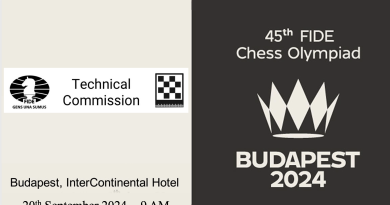Draft TRF 2025 (extensions for team pairing and tie-breaks)

Starting next year, there will be some changes in what used to be called the endorsement process, which was (and still is) described in Appendix A of Section C.04.
First, it will be called the FIDE Approval process, and it is the process that will allow the Technical Commission (“TEC”) to issue a certificate to the so-called “tournament handler program” (“THP”) guaranteeing that all the requirements that a THP must have are met. On the basis of this certificate, the THP producer will then be able to apply to FIDE for endorsement, but at this stage the TEC will no longer be directly involved.
Other than that, the main changes to the process are two:
(1) FIDE approval can also be requested for THPs running team tournaments and using the FIDE defined Team Pairing System (“TPS”) as their pairing system (TPS is currently defined in C.04.6).
(2) tie-breaks that are considered mandatory must be properly implemented (for the type of tournament for which FIDE approval is requested).
The Tournament Report File (or Format) (“TRF”) is the tool used since 2006 for the transmission of the results of a tournament to the FIDE Rating Server (“FRS”) by arbiters or Rating Officers.
The existence of such a tool, approximately since 2012, has been exploited by the Commission in charge of the approval of THPs (formerly the Swiss Pairing Programs, which then became the System of Pairings and Programs, and later merged into the Technical Commission – let’s use the acronym SPP anyway) to check the pairings. The 2006 format was redefined in 2014 (and then made official in 2016) to meet some SPP requirements, and has been a shared format between FRS and SPP ever since.
The core of any THP approval process was (and remains) the correctness of the pairings. Starting with the next cycle, final standings will also be added. So it is time for a redefinition.
The condition, never explicitly stated because it is taken for granted by the parties involved, is that any redefinition must not affect FRS activities in the slightest. Fortunately, the way the FRS is organized, it takes into account only certain codes (for which the definition is not only strict, but also immutable), and ignores all others. Thus, it is sufficient to *extend* the current TRF specification with new codes to avoid problems with the FRS.
Hence, the work of TEC has been to define *extensions* to the current TRF specification so that all new requirements can be supported without affecting FRS activity.
This did not work perfectly because a record (013) could not be effectively extended. Therefore, a new record (310) was created to carry the same information as the 013 record, plus other information essential to the new FIDE approval requirements.
THPs seeking FIDE approval for team tournaments will therefore be required to produce both records on a transitional basis, one because it is used by the FRS, the other for the FIDE approval phase. Once any TRF contains both records, the FRS can begin using only the 310 record for its business, and the 013 record can be discontinued.
Aside from the drawback just described, the TRF specification has been massively extended to handle team tournaments. However, for individual tournaments, and thus for all those that have been endorsed so far, the changes are moderately limited:
(a) code 092 (or another, if code 092 is used in any way by the FRS) has to carry the tournament type code (see document “Tournament Type Code Table (TRF code 092))
(b) codes 202 and 212 (only one of them may be present) were introduced to define the list of tie-breaks used in the tournament, by which the final ranking of the tournament was determined – the FIDE approval procedure will require that it is possible to use all the tie-breaks mentioned in the Mandatory Tie-Breaks document (see document “Mandatory Tie-Breaks“), which is part of the TRF extensions release.
(c) the 250 code was introduced to handle acceleration (per se, it would have been useful to have it in the past as well).
As anticipated just above, the most massive extensions to the TRF have been made to verify pairings and standings in team competition. In addition to the already mentioned record 310, which is supposed to replace 013, extensions have been introduced to clearly define the teams that receive the PAB and those that forfeit, and to include tournaments where the order of registration does not need to be followed when fielding teams. Then there are other extensions that are less likely to be used, but were deemed appropriate to include. Plus other records that are purely informational, so that it’s possible to understand a little more about the progress of the tournament. The current TRF specification only barely (and not rigorously) allows the reader to understand this.
This is the first draft of the new TRF specification and is not expected to be the last. It is hoped to receive feedback on how to complete and/or improve this format. The address trf@rrweb.org has been activated to receive such comments.
In addition to the new specification, as mentioned above, there are two other documents that describe the 092 (Tournament Type Code) record and the list of mandatory tie-breaks.
Then there is a third document, an example of a 50-team tournament described with the new specification (note: it was prepared by hand, so it is very likely that there are errors, which we will try to correct as they are found).
Annex-1: Tournament Type Code Table (TRF code 092)
Annex-2: Mandatory Tie-Breaks (draft update)
Annex-3: TRF 2025 sample


